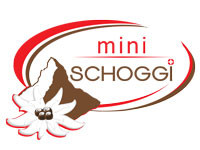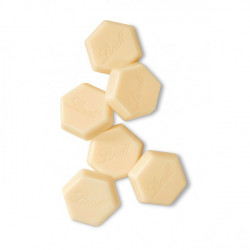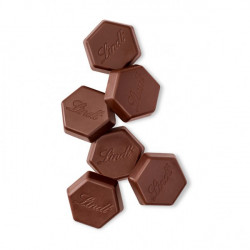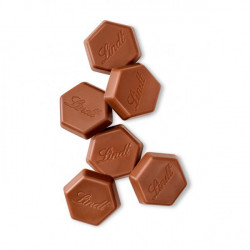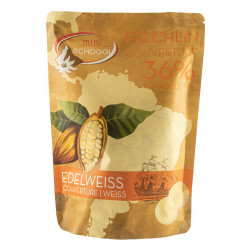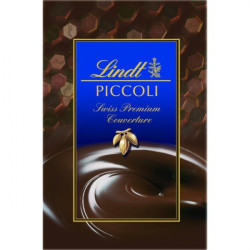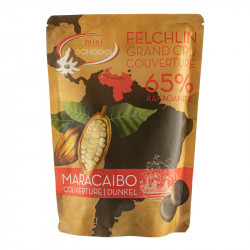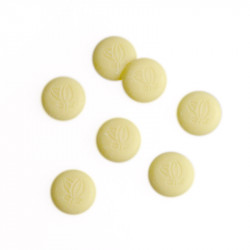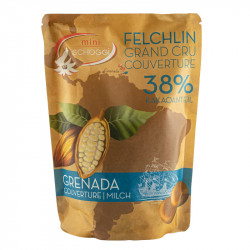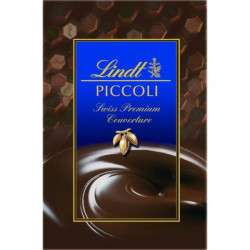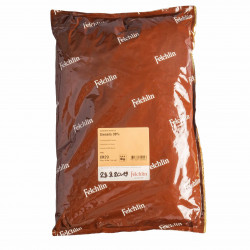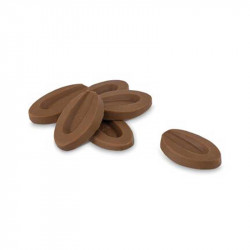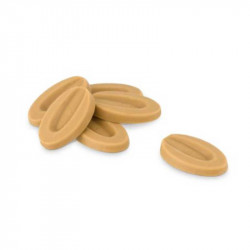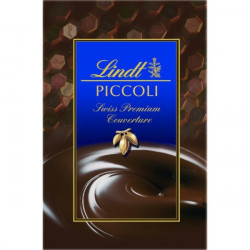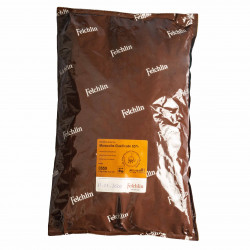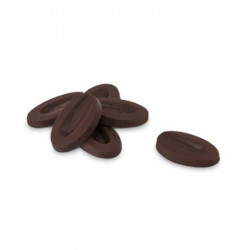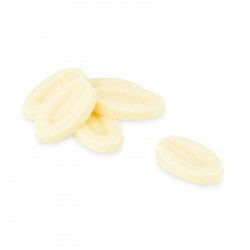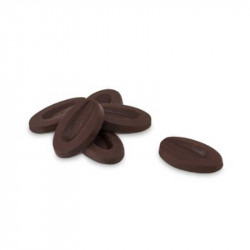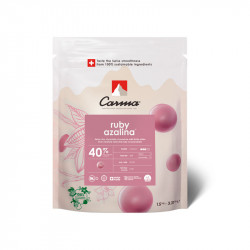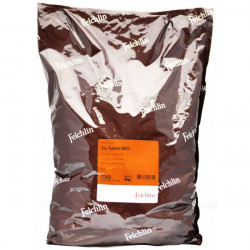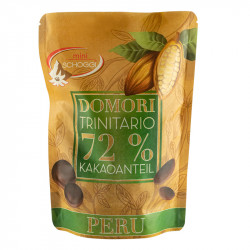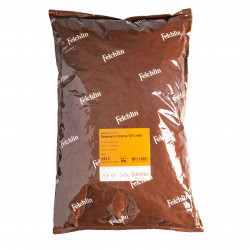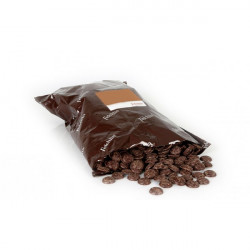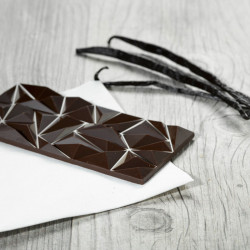All envelopes
What is the difference between chocolate, couverture and cake icing?
There are a variety of chocolate-like products on the market. It can be difficult to decide which ones are best for certain applications. In this article, we would like to explain the differences between normal chocolate, couverture/enrobing and cake or fat icing in order to provide you with clarity.Chocolate
Chocolate bars, which are available in every supermarket, have a lower cocoa butter content than couverture and therefore melt less easily. As a result, normal chocolate remains viscous and is not suitable for coating drizzled and cut chocolates with a thin layer. We therefore recommend that you do not use commercial chocolate to make pralines, bars or figures.Couverture
Couverture is the more refined version of chocolate, as it contains less sugar but a higher proportion of cocoa mass and cocoa butter. Although it is more expensive, it rewards you with an intense chocolate aroma and a perfect consistency for making chocolate bars, molded chocolates and other treats. Reach for couverture if you want to experience chocolate in its finest form or prepare a special dessert. Remember, it must be tempered before processing in order to achieve optimum results! Couverture is primarily available in three forms: as a whole block, as drops or grated. We recommend drops as they are the ideal size for further processing. As high-quality couverture is not easy to find, we offer a wide range of varieties from various manufacturers and countries of origin in our store in Adliswil and online, all in different packaging units. We only use and sell couverture of the highest quality. Sustainability and fair working conditions are also becoming increasingly important in this area.Refined chocolate | Chocolate icing | Cake melts
Refined chocolate is a chocolate-like mass that shines without tempering. The application is simple: place the packaging in warm water and leave it immersed until the contents are thick. You can knead the bag a little in between to distribute the heat evenly. Then pour the mixture over the cake or another piece of patisserie. The chocolate sets, becomes firm and shines beautifully. Cocoa butter is replaced with coconut or palm oil in the cake icing to save time and money. Although it cannot compete with chocolate in terms of taste, it is an inexpensive alternative. In confectionery, it is used for cakes, cupcakes, cake pops and confectionery, but not for high-quality confectionery products such as pralines or chocolate bars.Durability
For optimum storage and shelf life, chocolate, couverture and cake icing should be stored in a dark, cool and dry place. While the other two must be stored at a maximum of 18 degrees, it is not so important for cake icing as it does not contain any cocoa butter components. The shelf life depends on the variety. Normally, white chocolate, couverture or icing has the shortest shelf life of 6 months, followed by milk chocolate with 1 to 1 1/2 years and dark varieties with up to 2 years.Can I use normal chocolate instead of couverture?
Tempering is somewhat laborious and demanding, especially at the beginning, so the question quickly arises as to whether a conventional chocolate bar would not serve the same purpose. When it comes to baking or preparing a fluffy chocolate mousse, this is largely the case. As the pure chocolate does not need to be visible as a shiny coating in the finished product, it does not matter whether it has been heated and cooled correctly or not. The flow properties of the mass are often not decisive either, so chocolate bars can serve as an inexpensive alternative here.
However, when it comes to cut and molded chocolates, homemade chocolate bars or even an Easter bunny, couverture is indispensable. It is ideal for molding fine treats, as it becomes beautifully liquid and then has a perfect sheen. The use of chocolate would result in a massive loss of appearance and taste and often the hardened mass can hardly be removed from the polycarbonate molds. Unfortunately, it then has to be melted out with hot water.
So if you want to make cakes with chocolate pieces or a simple mousse, you can also use chocolate bars. However, if you want to create fine pralines, melt-in-the-mouth ganache or shiny and delicious coatings, you should always use couverture.
How is couverture tempered and processed?
For a glossy and crispy end result, couverture must be tempered. Here we explain how to do this at home using the injection method. You can find more tempering methods on our blog and if you would like to try and learn them, we recommend our tempering course.
The seeding method involves adding stable crystals in drop form to the dissolved mass.
First, two thirds of the desired quantity is melted at 45 °C.
Heating dissolves all the existing cocoa butter fat crystals. After cooling the mass and adding fresh couverture pieces, new stable fat crystal shapes can form.
The couverture pieces dissolve completely in the warm couverture mass and are distributed evenly by stirring. This is why this technique is called the seeding method. The liquid couverture without stable fat crystals is inoculated by adding solid, colder couverture pieces with stable crystals. Finally, it is brought to the specific optimum temperature. For example, dark-colored couverture with a high cocoa mass content must be brought to 32-33 degrees, while lighter varieties only need around 28 degrees. The optimum temperature is usually also indicated on the packaging. You can find more tips and tricks on our blog. Incidentally, a tempering device is practical, but not absolutely necessary. By ordering from our online store, you can have various temperature control units, from household helpers to professional devices, delivered directly to your home. These make the process easier by maintaining the set temperature. This allows you to devote yourself entirely to creating delicious chocolate bars or fine molded chocolates. However, it is also possible to heat the mixture over a bain-marie without any problems, but you should always keep an eye on the thermometer.
Light and dark couverture for cakes, chocolates, desserts and many other recipes
Chocolate is incredibly diverse in taste and application. From pralines to chocolate bars and delicate decorations to the basis of delicious chocolate mousses and sweet chocolate cakes. If you love chocolate as much as we do, but don't know exactly how you want to work with it, then you are always welcome to join our courses. We will teach you how to create all these delicacies at home, some of them made entirely from chocolate and sometimes, as with macarons, with just a small amount for maximum effect. If you're still looking for an idea for your next treat, you might just find it here.
Chocolates are always the right choice, because who doesn't love them as a gift, as a sweet treat between meals or as a special eye-catcher on the table or buffet. They are also very easy to make and can be adapted to suit existing skills. Experienced hobby confectioners can make the hollow shapes themselves or simply order them ready-made from us. As a rule, your purchase will be delivered the very next working day if you order before the specified order deadline.
If you prefer to buy the ready-made hollow shells, all that's missing is the filling and a nice coating. You can always fill the hollow shells with a simple ganache in the right color or add other ingredients as desired. Caramel and nuts, for example, go perfectly with the delicate aroma of milk in brown chocolate. For example, sprinkle caramelized and chopped almonds or hazelnuts into the hollow bodies, fill them halfway with caramel and then drizzle a delicate milk ganache on top. At least 3 mm should be left free around the edge, or a little more depending on the shape, so that the molded chocolates can then be sealed.
There are various delicious creations for dark chocolate. The ganache can be refined with various alcohols, coffee or orange paste, for example. In this case, however, you should be careful with the dosage, as you must not add too much liquid.
In white ganache, for example, pistachio paste, coconut flakes or some alcohols such as Baylies or Marc de Champagne are particularly delicious. Let your creativity run wild and try out different combinations!
If you are passionate about patisserie, chocolate is likely to be a beloved companion. It can be used to create crispy crunchy bases, fine mousses and exquisite coatings. The same also applies to creating cakes.
An elegant coating is created, for example, when you heat couverture and then mix it with cocoa butter. The stable fat crystals in it create a beautiful gloss, which is why it does not need to be tempered. If desired, this glaze can be refined or used directly for dipping or pouring over your treats.
Chocolate decorations are always eye-catching and incredibly delicious. With couverture, you can easily create most of them yourself. For example, you can create elegant chocolate spirals, small discs or molded drops. A cake fan, as you can see in the basic cake course 2, can also be created in no time at all using textured foil and colored cocoa butter. If you want to learn more about decorating with chocolate, we recommend our chocolate decorating course. You'll learn the right moves directly from a professional and can ask any questions you have. If something doesn't quite work out, you'll be given tips on your technique, so you don't have to worry and everyone can go home with an assortment of home-made decorations at the end.
Chocolate mousse can be made with full cream and chocolate bars from the supermarket, for example. However, if you want a richer and finer-tasting mousse, replace the chocolate bar with some couverture drops. This guarantees a great consistency and a delicious cocoa note. It can be made from all varieties, although the quantity varies slightly. A larger quantity of light couverture should be added than black couverture. If you would like to know exactly how to do this, we recommend the basic cake course 1 and the éclair course. In both courses, an airy chocolate mousse is made, in the former the couverture is added to the whipped cream, in the latter the ingredients are whipped together first. This results in two delicious mousses for various applications. You can hardly get enough of them!
